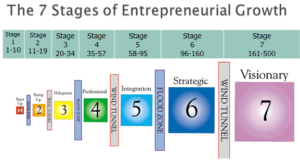As a small business owner, do you feel you are on a high wire without a safety line?
You are not alone. Most small business owners feel that no one is:
- Taking the risk out of running small business
- Identifying upcoming bumps in the road
- Helping owners focus on right things at right time
- Helping owners adapt to the needs of the company
Being a business owner is one of the hardest, most stressful, loneliest jobs. There is little margin for error. Every decision could mean more growth - or it could mean someone losing their job. Employees in a small business can be as close as family. Unlike big companies where “it’s just business,” in small companies it’s personal.
So what can be done?
What if there were a way to get a road map to help prepare for what is to come? What if there were a way to help steer clear of the major issues that most companies face? There is!
A researcher named James Fischer uncovered an entrepreneurial business formula for success by studying 650 companies over a 6 year period. He presents his research in a cleverly written book titled Navigating the Growth Curve. The book is written as a fictional story, but the key research findings are woven into each chapter. The business model has been boiled down into a matrix of key indicators (not included in the book) over 7 Stages of Growth that cover 1 to 500 employees.
The model is headcount driven because headcount drives complexity. You may have heard or seen models based on revenue, but I haven’t seen them work universally since there are companies making 10M in revenue with only 5 people. While there are outliers in every model, headcount is the most applicable when it comes to steering clear of pitfalls when growing.
Here are the stages:

In the Stages of Growth model, every stage of a company has its own top 5 challenges that are typically encountered. Each has its own key ratios of Builders vs Protectors, how much time the CEO should be spending on what activities, and what leadership style is most appropriate for that stage.
If a company makes it to Stage 3, that is a big milestone, but it is also the time when the owner/CEO has to change activities, style and modality. Most owners have difficulty moving from Commanding to Coaching, and from Dominant to Facilitative. The stage is called Delegation, because that is the biggest issue. Creating core values for the company is also important at this time if they don't already exist.
By that time a company reaches Stage 4, it will get stuck unless systems and processes are put into place. Up until now, there have been key people holding everything together and keeping the institutional knowledge. That breaks down in Stage 4 (if it didn’t already in Stage 3). Stage 4 is also the time when people who were perfect for Stage 1 and 2 may find they are not the right fit in the bigger company, causing turnover. Getting the right people in the right seats with the right attitude is one of the most difficult challenges for most companies, but processes and tools can overcome this.
If you’ve experienced these issues in the past, or worry you’ll hit them in the future, it’s time to get a plan or road map that will help circumvent these and future issues. If a key issue is not addressed at the right time, it does not go away – it will keep holding the company back, sometimes when it feels as if the company is just about to take off.
There is no reason to be that CEO who feels isolated. The best way to avoid these issues is to have your key stakeholders help assess the current situation (the CEO’s view is typically skewed), uncover the issues, and develop the key initiatives that will guide the company through the gauntlet. The Stages of Growth X-RayTM is the tool the facilitator uses to enable predicable growth.
If you want to stop the trial and error cycle, contact us to learn more about the Stages of Growth for your company.
